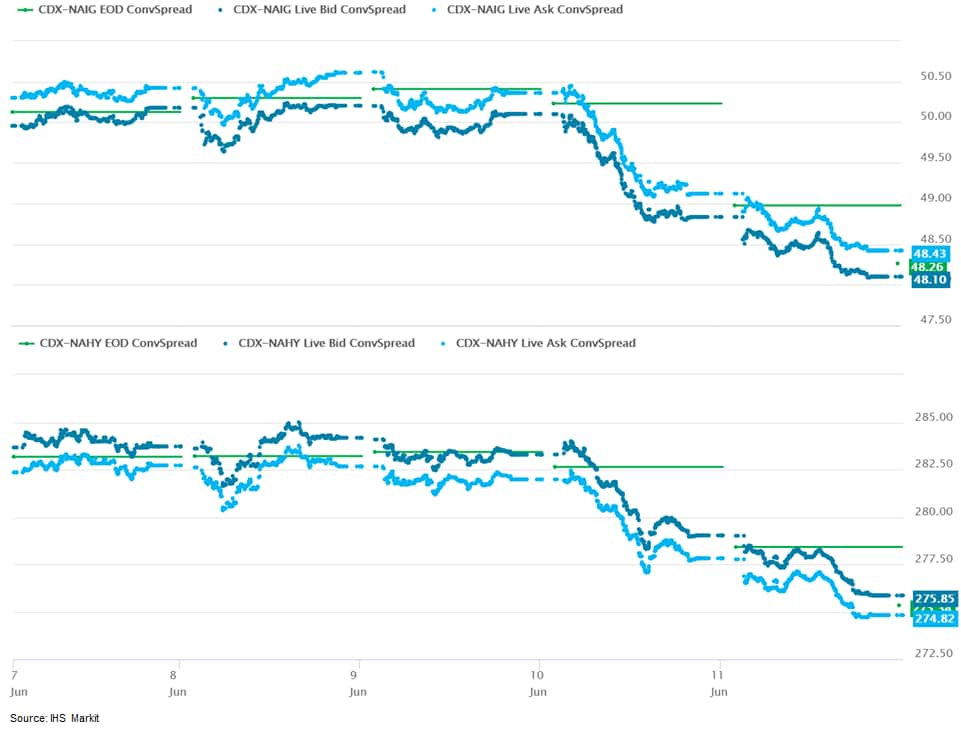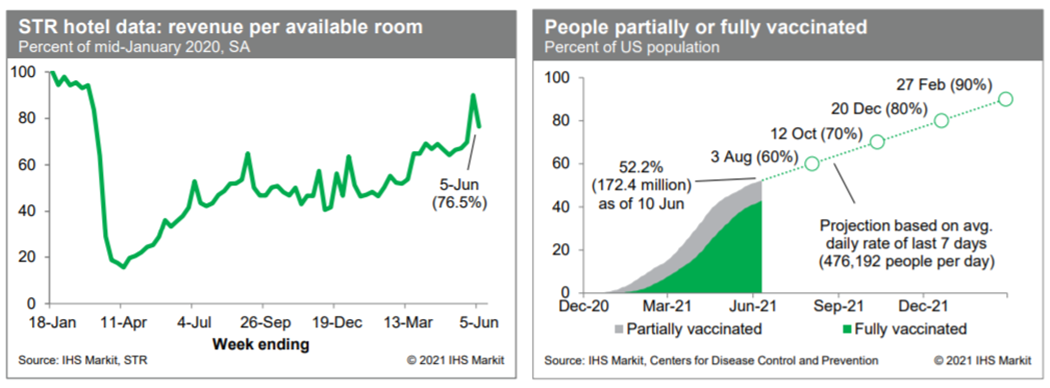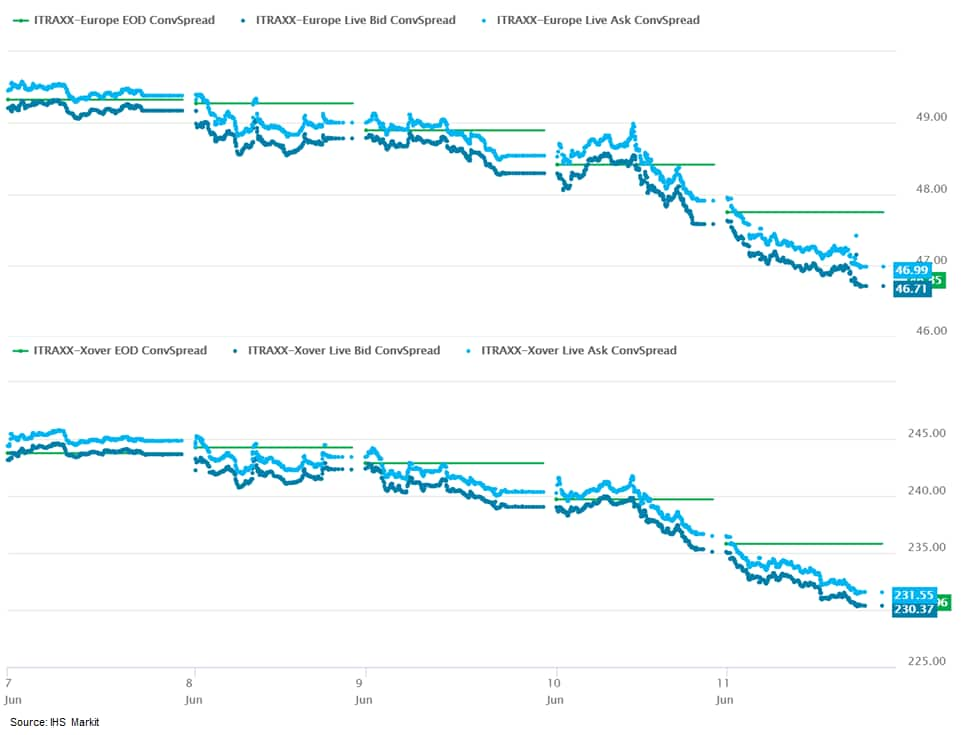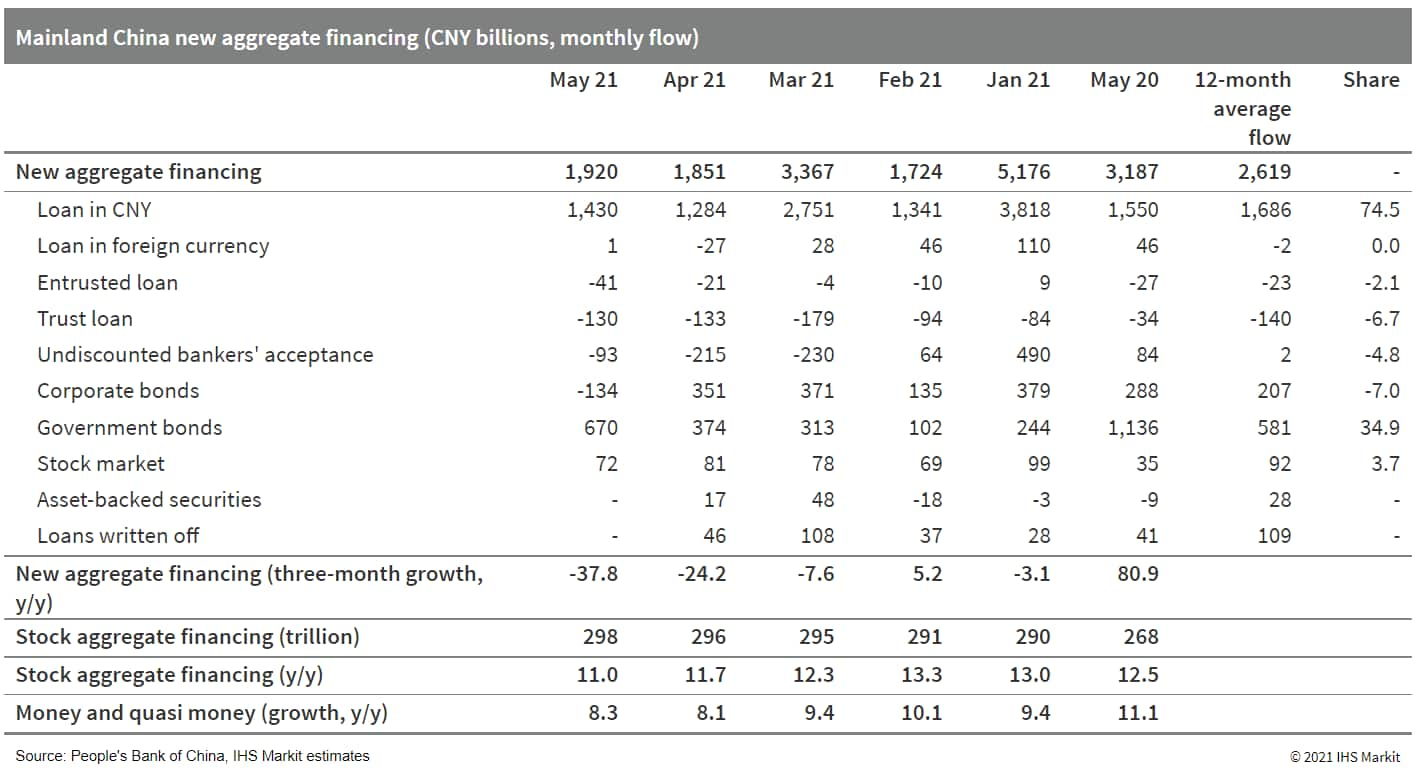Daily Global Market Summary - 11 June 2021
All major European and most US equity indices closed higher, while APAC was mixed on Friday. US government bonds closed slightly lower and benchmark European bonds were sharply higher. European iTraxx and CDX-NA closed modestly tighter across IG and high yield. The US dollar, oil, natural gas, silver, and copper closed higher, while gold was lower on the day.
Please note that we are now including a link to the profiles of contributing authors who are available for one-on-one discussions through our newly launched Experts by IHS Markit platform.
Americas
1. Most major US equity indices closed higher except DJIA closing
flat; Russell 2000 +1.1%, Nasdaq +0.4%, and S&P 500 +0.2%.
2. 10yr US govt bonds closed +1bp/1.45% yield and 30yr bonds
+1bp/2.14% yield.
3. CDX-NAIG closed -1bp/48bps and CDX-NAHY -3bps/275bps, which is
-2bps and -8bps week-over-week, respectively.

4. DXY US dollar index closed +0.5%/90.56.
5. Gold closed -0.9%/$1,880 per troy oz, silver +0.4%/$28.15 per
troy oz, and copper +1.2%/$4.54 per pound.
6. Crude oil closed +0.9%/$70.91 per barrel and natural gas closed
+4.7%/$3.30 per mmbtu.
7. The US University of Michigan Consumer Sentiment Index rose 3.5
points (4.2%) to 86.4 in the preliminary June reading, erasing a
portion of a 5.4-point decrease in May. The reading suggests that
consumers have not lost confidence in the recovery despite rising
prices, and is consistent with our expectation for robust consumer
spending growth in the second quarter. (IHS Markit Economists David
Deull and James
Bohnaker)
a. The June increase in consumer sentiment was driven mainly by
expectations, the index for which rose 5.0 points to 83.8, a new
pandemic-era high. The index measuring views on the present
situation rose 1.2 points to 90.6.
b. Supporting the increase in expectations was a record high in the
proportion of respondents expecting a further decline in the
unemployment rate. The mean expected probability of an increase in
respondents' personal income rose to 54%, just short of its
pandemic-era high.
c. The expected one-year inflation rate stepped back to 4.0% from a
reading of 4.6% the prior month. The expected 5-to-10-year
inflation rate fell 0.2 percentage point to 2.8%. Despite this
moderation, prices remain highly salient to consumers; the measure
of net negative references to prices of homes, autos, and durable
goods was the most pronounced since 1974.
d. The increase in consumer sentiment was expressed entirely by
upper-income households. The index of sentiment for households
earning more than $75,000 a year rose 5.9 points to 92.8, while
sentiment for households earning less fell by 1.1 points to 78.2,
the lowest since February.
e. Views on buying conditions for big-ticket items worsened to
multidecade lows in June. The index of buying conditions for large
household durable goods rose 5 points to 116, but that of vehicles
fell 11 points to 89, while that of homes dove 16 points to 74.
Both were the lowest since 1982.
f. Price pressures remain concerning for consumers, especially
those with low incomes, but tight labor markets and equity markets
scraping record highs are supporting expectations for continued
recovery.
8. Revenues at US hotels last week, after seasonal adjustment, were
about 76.5% of the mid-January 2020 level (our estimate based on
weekly data from STR). This is down from the prior week, likely
reflecting volatility due to the timing of the Memorial Day
weekend. Still, averaged over the last two weeks, hotel activity is
up considerably from earlier in the spring. Meanwhile, averaged
over the last seven days, about 476,000 people per day received a
first (or only) dose of a COVID-19 vaccination, down somewhat from
an average daily rate of about 482,000 per day over the prior week.
As of yesterday, 172.4 million US residents, or about 52% of the
population, were at least partially vaccinated against COVID-19. At
the current rate, the US would achieve widespread vaccination
(70-80%) by this fall. (IHS Markit Economists Ben
Herzon and Joel
Prakken)

9. Three members of the US FDA's Peripheral and Central Nervous
System Drugs Advisory Committee have now resigned in protest at the
agency's decision to approve US firm Biogen's Aduhelm
(aducanumab-avwa) for Alzheimer's disease (AD). The first member to
resign was Dr Joel Perlmutter, a neurologist from the Washington
University School of Medicine in St. Louis. His resignation was
shortly followed by those of Dr David Knopman, who is a clinical
neurologist from the Mayo Clinic, and Dr Aaron Kesselheim, who is a
professor of medicine at Harvard Medical School. According to CNBC,
Kesselheim's resignation letter described Aduhelm's approval as
"probably the worst drug approval decision in recent US history".
The resignation letter also claimed that the FDA is not "presently
capable of adequately integrating the Committee's scientific
recommendations into its approval decisions", and that Aduhelm's
approval "will undermine the care of [AD] patients, public trust in
the FDA, the pursuit of therapeutic innovation, and the
affordability of the health care system". (IHS Markit Life
Sciences' Milena
Izmirlieva)
10. US almond shipments in the first 10 months of the 2020-21 crop
year (August 2020-May 31 2021) reached a record level of 2.448
billion pounds, more than has been shipped in any year in 12
months. (IHS Markit Food and Agricultural Commodities' Julian
Gale)
a. In his monthly letter to industry members, Richard Waycott,
president and chief executive of the ABC, remarked: "All regions of
the world performed well during the month. Increases in western
Europe were led by Spain, Italy and the Netherlands. In the Middle
East, the UAE, Turkey and Saudi Arabia experienced strong demand.
Asian shipments were boosted by higher imports in China, Vietnam,
Japan and a more modest increase in India. Morocco continued to
amaze importing over 11 million pounds in the month, up from 2.3
million pounds last year."
b. The May position report from the Almond Board of California
(ABC) showed that domestic shipments last month were at 69.89
million pounds versus 57.15 million pounds in May 2020.
c. This brought domestic shipments for the 10-month period to
671.94 million pounds, 3.7% up from the 647.6 million pounds
reached in the August 2019-May 31 2020 period.
d. Export volumes reached 149.51 million pounds this May compared
with 96.73 million pounds in the same month a year ago, bringing
the seasonal export total to 1.77 billion pounds from 1.37 billion
pounds in the first 10 months of 2019-20 - an increase of
29.7%.
e. The total shipments of 2.448 billion pounds were 21.4% up from
2.016 billion pounds achieved in August 2019-May 31, 2020.
11. Beep, in partnership with Local Motors, has launched autonomous
shuttle trials at Yellowstone National Park in the United States,
according to a company statement. These trials form part of an
autonomous shuttle program, called T.E.D.D.Y (The Electric
Driverless Demonstration in Yellowstone), to test the feasibility
and sustainability of autonomous mobility. The autonomous shuttle
Olli, developed by Local Motors, will travel on two routes until 31
August, gathering important information such as ridership, route
optimization, and overall vehicle operations. (IHS Markit
Automotive Mobility's Surabhi Rajpal)
12. Waymo has partnered with transportation logistics company J.B.
Hunt to launch an autonomous truck pilot in Texas, United States,
according to a company statement. Under this partnership, Waymo
Via, the company's trucking and cargo transportation service, will
be autonomously hauling freight on the I-45 corridor between
facilities in Houston and Fort Worth for one of JB Hunt's
customers. The trucks will be powered by the Waymo Driver
autonomous platform, although a commercially licensed driver and a
software technician will be on-board to monitor operations. (IHS
Markit Automotive Mobility's Surabhi Rajpal)
Europe/Middle East/Africa
1. Most major European equity indices closed higher; France +0.8%,
Germany +0.8%, Spain +0.8%, UK +0.7%, and Italy +0.3%.
2. 10yr European govt bonds closed higher; Italy -5bps, UK -4bps,
France/Spain -3bps, and Germany -2bps.
3. iTraxx-Europe closed -1bp/47bps and iTraxx-Xover -5bps/231bps,
which is -2bps and -13bps week-over-week, respectively.

4. Brent crude closed +0.2%/$72.69 per barrel.
5. Bank for International Settlements (BIS) Thursday (10 June)
started a consultation regarding capital treatment for banking
sector exposures to crypto-currency assets, proposing the maximum
1,250% capital weighting for unregulated mechanisms. The BIS's
proposals, open for consultation until 10 September, suggest two
categories for crypto-assets. Those in Group 1 must meet four
conditions (IHS Markit Economist Brian
Lawson):
a. First, they must be either a tokenized traditional asset or be
permanently linked within narrow boundaries to a traditional
asset.
b. Second, they must be subject to a clearly defined and
enforceable legal framework within a specified jurisdiction.
c. Third, they must be designed and operated in a way to "manage
any material risks", including the provision of "robust risk
governance and risk control policies" in areas such as anti-money
laundering (AML)/combating the financing of terrorism (CFT) and
fraud, alongside operational risk and credit, market, and liquidity
controls.
d. Fourth, entities that operate the crypto-asset must be subject
to official regulation and supervision.
6. The Office for National Statistics (ONS) reports that the UK
economy grew by 2.3% month on month (m/m) in April, after a 2.1%
m/m gain in March. (IHS Markit Economist Raj
Badiani)
a. GDP shrank by 1.5% quarter on quarter (q/q) in the first three
months of 2021.
b. GDP was still 3.8% below the level before the first
COVID-19-related lockdown in February 2020.
c. The figure for April this year was marginally below the market
consensus, which had predicted a 2.4% m/m gain during the
month.
d. A breakdown by type of output reveals that the services sector
increased by 3.4% m/m in April but was still 4.1% lower than the
February 2020 level.
e. Consumer-facing services grew by 12.7% m/m as COVID-19-related
restrictions eased throughout April, returning to a level last seen
during their initial recovery peak in October 2020.
f. Retail sales volumes grew by 9.2% m/m in April, lifted by the
reopening of all non-essential retail from 12 April in England and
Wales and from 26 April in Scotland.
g. Meanwhile, accommodation and food and beverages service
activities grew by 68.6% m/m and 39.0% m/m, respectively. A key
change was that pubs, restaurants, and cafés were able to serve
customers in outdoor seating areas from 12 April. Other personal
service activities (including hairdressing) grew by 63.5% m/m in
April as hairdressing reopened in England on the same day.
h. The ONS reports that consumer-facing services were 5.9% below
their pre-pandemic levels (February 2020), while all other services
were 3.7% below their pre-pandemic levels.
7. Daimler AG, BASF, Fairphone, and Volkswagen Group have created a
partnership, the German Society for International Cooperation
(Deutsche Gesellschaft fur Internationale Zusammenarbeit: GIZ), to
bring together stakeholders to ensure responsible lithium mining in
Chile's Sala de Atacama watershed. According to a joint press
statement, the partnership "intends to foster a dialogue among
local stakeholders, generating and synthesizing scientific facts
and seeking solutions in a participatory manner". According to the
statement, the world's largest lithium reserves and a large part of
lithium production are in this area of Chile, but the region's
ecosystem is fragile. The group states that there is a lack of
consensus on the impacts and risks of lithium mining and economic
activity in the region, with particular concern over shifts in the
water and brine tables. (IHS Markit AutoIntelligence's Stephanie
Brinley)
8. French payroll employment rose by 89,000, or 0.3% quarter on
quarter (q/q), during the first quarter of 2021, according to
figures released by the National Institute of Statistics and
Economic Studies (Institut national de la statistique et des études
économiques: INSEE). This followed a decline of 0.1% during the
final three months of 2020. (IHS Markit Economist Diego
Iscaro)
a. Employment was driven by the private sector, which added nearly
89,000 new jobs during the first quarter (+0.5% q/q).
b. The construction sector added around 20,000 new jobs (+1.4%
q/q), while employment in the manufacturing sector was stable.
Employment in the service sector rose by 48,000 (+0.4% q/q).
c. Despite the first-quarter rise, employment in the private sector
remains 243,400 below its level during the fourth quarter of 2019.
Only employment in the construction sector is higher than before
the pandemic. On the other hand, employment in the public sector
declined by 2,700. Public-sector employment has still increased by
33,600 since the start of the pandemic.
9. The Italian government is spearheading a program that will
commit EUR1 billion (USD1.22 billion) of funding to the
construction of a 'Gigafactory' to make battery cells for battery
electric vehicles (BEVs), according to a Reuters report. As part of
this initiative, the Italian government has sent a proposal to the
European Union (EU) to access EUR600 million from its EU Recovery
Funds aimed at boosting economic growth across the bloc in the
post-COVID-19 environment. However, according to Italian government
sources, the state is looking to bolster this figure to over EUR1
billion through private investment, with Stellantis being at the
center of these plans. (IHS Markit AutoIntelligence's Tim
Urquhart)
10. CBD of Denver, listed on the US OTC exchange, has started to
build a factory in its Swiss headquarters, focused on warehousing
its products for the European markets. The plant will have a
processing capacity of 24 tons of hemp annually, producing CBD
products with European hemp. "We were dependent on external
partners and with this expansion we are improving our service," the
sales manager of CBD of Denver, Pascal Siegenthaler, said. The
company produces and commercializes CBD products with its Rockflowr
and BlackPearlCBD brands. Its revenues totaled USD30 million, 22%
more year-on-year, from June 2020-May 2021. (IHS Markit Food and
Agricultural Commodities' Jose Gutierrez)
Asia-Pacific
1. Major APAC equity markets closed mixed; South Korea +0.8%, Hong
Kong +0.4%, India +0.3%, Australia +0.1%, Japan 0%, and Mainland
China -0.6%.
2. Mainland China's total social financing (TSF) - the broadest
measure of net new financing to the real economy - amounted to
CNY1.92 trillion (USD298 billion) in May, according to the People's
Bank of China (PBOC). Owing to the relatively high baseline, the
May TSF reading marks a year-on-year (y/y) decline of CNY1.27
trillion, although it remains higher than the comparable 2019 level
by CNY208.1 billion. Stock TSF reached CNY298 trillion in May, up
by 11.0% y/y -marking the third consecutive month of stock TSF
growth rate decline. (IHS Markit Economist Lei Yi)
a. The year-on-year new TSF decline in May was broad across
sub-categories, led by government and corporate bonds. Fiscal
spending has stayed on the lower end so far this year, and notably
the pace of special-purpose bond issuance has remained
sluggish.
b. However, government bond issuance did post a significant
month-on-month (m/m) increase in May, which may suggest a pickup in
momentum in the second half of the year. On the corporate front,
net new TSF from corporate bonds registered a negative reading in
May, the lowest reading since mid-2017; this may be the result of
the financial de-risking campaign weighing on leverage buildup,
with debt expansion of property developers and implicit local
government debt being major targets.
c. Broad money supply (M2) expanded 8.3% y/y in May, up by 0.2
percentage point from the prior month. M1 grew by 6.1% y/y, down
0.1 percentage point from April.

3. Chinese telecoms equipment giant Huawei Technologies aims to
offer driverless passenger car solutions by 2025, reports China
Daily. Wang Jun, senior executive at Huawei's smart vehicle unit,
said, "Driverless vehicles are the ultimate goal of autonomous
driving, and we are working to make passenger vehicles driverless
in 2025". (IHS Markit Automotive Mobility's Surabhi Rajpal)
4. China's ride-hailing giant Didi Chuxing (DiDi) made public its
filing for US stock market listing. According to a report by
Reuters, DiDi could raise around USD10 billion and seek a valuation
of close to USD10 billion for its initial public offering (IPO). In
its filing, DiDi revealed slower revenue growth between 2019 and
2020 due to COVID-19 pandemic-related lockdowns imposed all over
the globe. In 2020, DiDi reported revenue of CNY141.7 billion
(USD22.2 billion), down from CNY154.8 billion (USD24.2 billion) a
year earlier. Net loss in 2020 amounted to CNY10.6 billion (USD1.6
billion), compared with CNY9.7 billion (USD1.5 billion) in 2019.
However, DiDi made a solid start in 2021, as business reopened in
China. Revenue more than doubled to CNY42.2 billion (USD6.6
billion) for the quarter ending 31 March, from CNY20.5 billion
(USD3.2 billion) a year earlier. (IHS Markit Automotive Mobility's
Surabhi Rajpal)
5. Chinese electric vehicle (EV) startup AIWAYS is preparing to
enter the Italian market with local partner Koelliker Group and
plans to introduce its electric sport utility vehicle (SUV), the
U5, in the country later this year, reports electrive.com. The
automaker is said to have shipped around 2,500 vehicles to Europe
since May 2020. Alex Klose, executive vice-president of overseas
operations at AIWAYS, said, "Our exciting product and their
[Koelliker's] proven track record in sales and marketing of foreign
cars will give us the best chance of attracting Italian electric
car buyers to the Aiways brand." (IHS Markit AutoIntelligence's
Nitin Budhiraja)
6. Japan's current Business Survey Index (BSI) for large
enterprises fell by 0.2 point to -4.7 in the Business Outlook
Survey for the second quarter of 2021. The BSI for large
manufacturing declined to -1.4, marking the first negative figure
in four quarters, largely reflecting the negative effects of
semiconductor shortages on auto manufacturers. (IHS Markit
Economist Harumi
Taguchi)
a. The contractions in BSIs for manufacturing and non-manufacturing groupings narrowed for all sized enterprises, except for large manufacturing. However, the resurgence of COVID-19 and the negative impacts of the state of emergency continued to dampen business conditions for a broad range of industries, particularly for small-sized enterprises.
b. Projected sales and ordinary profits for all industries in
fiscal year (FY) 2021/22 (ending in March 2022) were revised down
to a 2.8% year-on-year (y/y) rise from a 3.2% y/y increase and to a
6.8% y/y rise from an 8.8% y/y increase, respectively, reflecting
the negative effects of supply-chain disruptions and prolonged
containment measures.
c. Fixed investment plans in FY 2021/22 for manufacturing were
revised up to a 10.7% y/y rise from a 7.9% y/y increase thanks
largely to robust plans of chemical, non-ferrous metal, production
machinery, and some other groupings. A downward revision for fixed
investment plans for non-manufacturing largely reflected weaker
plans in retail sales, real estate, and services (such as amusement
and life-related services).
7. South Korea's 'hangover-release' drinks market was worth KRW250
billion (USD225 million) in 2019, up 60% from 2016 as the previous
customer base of 30-40 year-olds has now extended to people in
their 20s. Currently, HK inno.N leads the market with its Hutgae
Condition, which has a 44% market share, followed by Grammy's Dawn
808 with 32%, and Dong-A Pharmaceutical's Morning Power with 14%.
After selling three million cans in just half a year after the
introduction of carbonated 'Kaesugang', Lotte Chilsung Beverage has
recently launched its 'Kesu Kwang Phan'. The drink contains seven
types of Jeju-derived ingredients, which are claimed to be
excellent in hangover relief, such as green tea leaves, five types
of seaweed, mandarin peel and patented hangover relief ingredients.
The company plans to establish a 'Big 5' system for these drinks.
(IHS Markit Food and Agricultural Commodities' Mainbayar
Badarch)
8. India is set to install nearly 20.2 GW of wind power capacity
through 2025, raising capacity in the world's fourth-largest wind
power market by more than 50% from the 39.2 GW currently up and
running, according to a study released 10 June. The study,
published by the Global Wind Energy Council (GWEC), and titled
India Wind Energy Market Outlook 2025, found a 10.3-GW pipeline of
projects in federal (or central) and state markets is expected to
drive installations until 2023. After 2023 though, growth is likely
be pushed forward by almost 10 GW of capacity awarded to wind
projects through mainly hybrid tenders, it said. Hybrid tenders
combine wind and solar in an effort produce a higher capacity
utilization factor. Through 2025, 90% of new installed wind
capacity will come from federal government tenders, GWEC said.
While GWEC expects installed Indian wind capacity to total 59.4 GW
at the end of 2025, it said there is a chance under an "ambitious
case projection" model that as much as 62.9 GW of capacity could be
up and running by that point. (IHS Markit Climate and
Sustainability News' Keiron Greenhalgh)
S&P Global provides industry-leading data, software and technology platforms and managed services to tackle some of the most difficult challenges in financial markets. We help our customers better understand complicated markets, reduce risk, operate more efficiently and comply with financial regulation.
This article was published by S&P Global Market Intelligence and not by S&P Global Ratings, which is a separately managed division of S&P Global.
